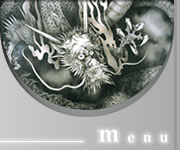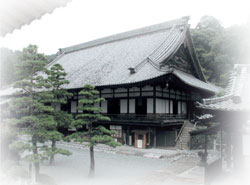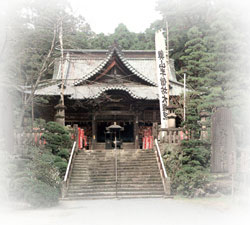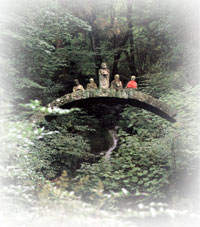

|
Top >
Head Temples -
Hoko-ji Temple
Head TemplesTemple Name: Hoko-ji 方廣寺Mountain Name: Shinnozan 深奥山Address: 1577-1 Okuyama Inasa-cho, Hamamatsu-shi, Shizuoka-ken, 431-2224
Japan
 Hoko-ji, located deep
in the mountains of western Shizuoka Prefecture north of the city of
Hamamatsu, is the head temple of the Hoko-ji branch of Rinzai Zen, with
approximately 170 associated temples. It was established in 1371 by the
regional lord, Okuyama Rokuro Jiro Tomofuji 奥山六郎次郎朝藤, who invited as
founding abbot Mumon Gensen 無文元選 (1323–1390), a son of Emperor Go-Daigo 後醍醐
(r. 1319–1339). Gensen had become a monk at Kennin-ji and trained under the
masters Kao Sonen 可翁宗然 (d. 1345) and Sesson Yubai 雪村友梅 (1290–1346). In 1343
he went to China, where he practiced under the master Gumei Zhengyou 古梅正友
(1285–1352). After receiving the Dharma Seal of the master he traveled
further in China, residing for a time at Tiantaishan 天台山. In 1350 Mumon
returned to Japan and did further practice in the mountains near Shizuoka,
where Okuyama Rokuro Jiro Tomofuji studied Zen under him. Hoko-ji, located deep
in the mountains of western Shizuoka Prefecture north of the city of
Hamamatsu, is the head temple of the Hoko-ji branch of Rinzai Zen, with
approximately 170 associated temples. It was established in 1371 by the
regional lord, Okuyama Rokuro Jiro Tomofuji 奥山六郎次郎朝藤, who invited as
founding abbot Mumon Gensen 無文元選 (1323–1390), a son of Emperor Go-Daigo 後醍醐
(r. 1319–1339). Gensen had become a monk at Kennin-ji and trained under the
masters Kao Sonen 可翁宗然 (d. 1345) and Sesson Yubai 雪村友梅 (1290–1346). In 1343
he went to China, where he practiced under the master Gumei Zhengyou 古梅正友
(1285–1352). After receiving the Dharma Seal of the master he traveled
further in China, residing for a time at Tiantaishan 天台山. In 1350 Mumon
returned to Japan and did further practice in the mountains near Shizuoka,
where Okuyama Rokuro Jiro Tomofuji studied Zen under him.
|

 Among Hoko-ji’s notable
buildings is the Hanzobo Daigongen 半僧坊大權権現 (middle photo). The Hanzobo Daigongen
was built in honor of a deity that is said to have appeared to Mumon Gensen
when his ship encountered a storm on the way back from China. The deity,
vowing that he would protect Mumon so that he could return to Japan to teach
the Dharma, guided the captain and helped the ship survive the storm. Later,
after Mumon had become priest of Hoko-ji, the deity appeared again and asked
to study Zen. He was dressed partly as a monk and partly as a layman, so the
master called him Hanzobo 半僧坊, “Half-monk.”
Among Hoko-ji’s notable
buildings is the Hanzobo Daigongen 半僧坊大權権現 (middle photo). The Hanzobo Daigongen
was built in honor of a deity that is said to have appeared to Mumon Gensen
when his ship encountered a storm on the way back from China. The deity,
vowing that he would protect Mumon so that he could return to Japan to teach
the Dharma, guided the captain and helped the ship survive the storm. Later,
after Mumon had become priest of Hoko-ji, the deity appeared again and asked
to study Zen. He was dressed partly as a monk and partly as a layman, so the
master called him Hanzobo 半僧坊, “Half-monk.” Another notable structure
is the Shichison Bosatsudo 七尊菩薩堂 (Important Cultural Property), a shrine
built in 1401 that honors seven Shinto deities and Buddhist bodhisattvas.
Hoko-ji is also known for its stone images of the Five Hundred Arhats (the
five hundred enlightened disciples of Shakyamuni Buddha), located at various
places around the temple grounds, including atop a stone bridge (photo to
right).
Another notable structure
is the Shichison Bosatsudo 七尊菩薩堂 (Important Cultural Property), a shrine
built in 1401 that honors seven Shinto deities and Buddhist bodhisattvas.
Hoko-ji is also known for its stone images of the Five Hundred Arhats (the
five hundred enlightened disciples of Shakyamuni Buddha), located at various
places around the temple grounds, including atop a stone bridge (photo to
right).